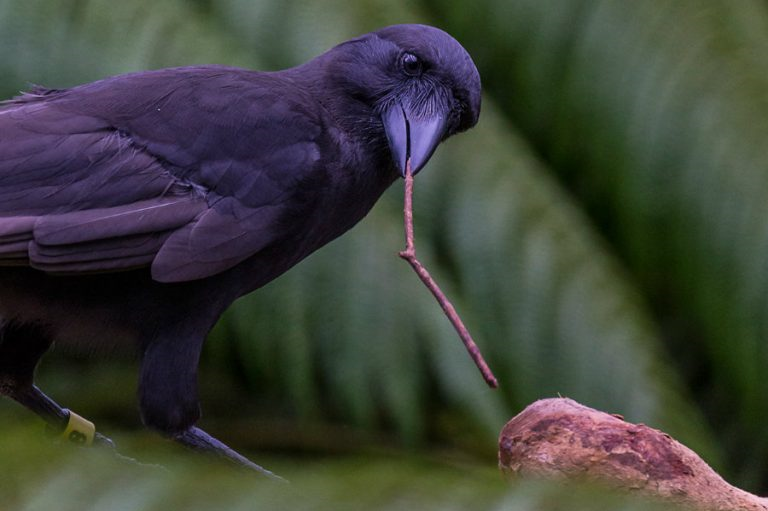Feature Image Credit Ken Bohn / San Diego Zoo Global New Scientist
by Laura Steel
Humans are constantly creating novel compound tools from otherwise non-functional elements. From large scale technologies such as cars, to simply tying two non-functional bits of string together to make a useful longer piece. This skill comes so easily to us that it seems we hardly think about it. However, before now, this specialised form of behaviour known as compound tool construction, has not been witnessed outside of humans and great apes. A few weeks ago, an international team of scientists from the Max Planck Institute for Ornithology in Germany and the University of Oxford published remarkable findings in Nature. Their study demonstrated that New Caledonian Crows were capable of Compound Tool construction. Through a series of elegant experiments, they showed that these birds can create long reaching tools out of short combinable, but otherwise useless parts, to reach a food reward1.
Innovative tool manufacture is intimately associated with human evolution; archaeological findings indicate that compound tool use in our populations arose around 300,000 years ago. This is relatively late in human cultural evolution, but is likely to have co-evolved with specific neurological capacities related to planning, complex task coordination and even language. Humans capacity for innovative tool manufacture starts aged five to nine, this supports the idea that a level of cognitive function is required for compound tool construction. The crow’s ability to construct novel compound tools does not directly suggest that they possess cognitive mechanisms equal to those of humans or apes. However, it does provide a novel and independently evolved biological model to help us understand the cognitive processes that are needed for physical problem solving; which currently remain largely opaque.
The researchers on this project presented eight wild caught New Caledonian Crows, from the South Pacific, with a problem-solving task they had never encountered before. The task consisted of a transparent box with a food reward positioned in a groove, requiring it to be pushed along to a side opening with a stick. Initially, the scientists left some sufficiently long sticks scattered around and all the birds successfully and rapidly completed the task. The next step retained the same the layout although only short, but potentially combinable pieces were provided. These included barrels and plungers from syringes. Without any demonstration, four of the crows pushed the barrels and plungers together to create a sufficiently long compound tool to successfully extract the food. One bird called Mango managed to outperform the rest; constructing compound tools out of three and even four parts – a truly extraordinary feat.

Outside of humans this behaviour has only been shown before in Sultan the chimpanzee, who made a useful compound pole. But crucially this was only after being coached by a human demonstrator and it took him almost an hour – positively slow compared to the 4-6 minutes it took the crows. Furthermore, they constructed their compound tools with no cues. As author Aguste von Bayern said, “the finding is remarkable because the crows received no assistance or training in making these combinations, they figured it out by themselves”.
So, are crows now deemed ‘intelligent’ species? To answer this, one needs to do two things: define intelligence – which is too meaty a topic to go into now, and secondly, figure out how these crows created their compound tools. Was it through invention and virtual mental modelling – i.e. creatively coming up with the solution by simulating different options with neural representations of the real objects; or was it accidental? The latter may have come about through the solid stick getting stuck within the hollow shorter element whilst searching for food. Then having found it useful for reaching the food, this approach was adopted through reinforcement learning. If this was the case, it is still an interesting discovery, and certainly more easily explained since it relies on known neurological processes. However, the crow’s food searching was very focused on the box with the visible bait rather than within the tools themselves, and furthermore, Mango produced a tool with 4 elements. The chances of accidental creation of compound tools happening not once but three times seems unlikely, leading to the authors concluding that this behaviour may be evidence for “higher” cognitive processes and flexible tool related abilities.
1 Von Bayern, A, Auersperg, A, Mioduszewska, B, Danel, S, and Kacelnik, A., September 2018 , “Compound Tool Construction by New Caledonian Crows.”Nature.





